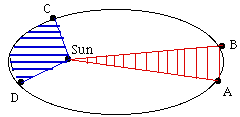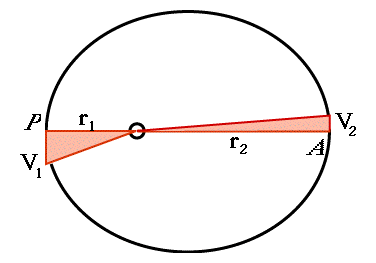|
(That line is sometimes called "the radius vector").
 |
Illustrating Kepler's 2nd law:
segments AB and CD take
equal times to cover. |
An ellipse is symmetric elongated oval, with two foci symmetrically locates towards the "sharper" ends--one focus contains the Sun, the other is empty. (Draw such an ellipse.)
If we bring the foci closer and closer, the ellipse appears more and more like a circle, and when they overlap, we do have a circle.
[ The Earth's orbit, and most planetary orbits, are very close to circles. If one you were shown the Earth's orbit without the Sun at the focus, you would probably not be able to distinguish it from a circle. With the Sun included, though, you might notice it was slightly off-center.]
The point of Kepler's 2nd law is that, although the orbit is symmetric, the motion is not.
A planet speeds up as it approaches the Sun, gets its greatest velocity when passing closest, then slows down again.
(The star S2 speeds up to 2% of velocity of light when approaching the black hole at the center of our galaxy!)
What happen is best understood in terms of energy. As the planet moves away from the Sun (or the satellite from Earth), it loses energy by overcoming the pull of gravity, and it slows down, like a stone thrown upwards. And like the stone, it regains its energy (completely--no air resistance in space) as it comes back.
There is an easy exercise here, which is also in section #12A
http://www.phy6.org/stargaze/Skepl2A.htm
Suppose you have a planet whose smallest/greatest distance from the center are
(r1, r2)--they are called perihelion and aphelion [ap-helion]) if the center is the Sun, or (perigee, apogee) if the center is the Earth. (Distances are always measured from the center of the bodies, or from centers of gravity)

Say it is a planet orbiting the Sun. Then
-- the velocity V1 at perihelion is the fastest one for the orbit. It is therefore the distance covered in one second at perihelion.
-- the velocity V2 at aphelion is the slowest one for the orbit. It is therefore the distance covered in one second at aphelion.
The area swept by the "radius vector" r during one second after perihelion is a right-angled triangle of base V1,
so its area is 0.5 r1 V1
The area swept by the "radius vector" r during one second after aphelion is a right-angled triangle of base V2,
so its area is 0.5 r2 V2
By the law of areas, both areas are the same, so
r1 V1 =
r2 V2
Divide both sides by r1V2
and get
V1:V2 =
r2:r1
If the aphelion r2 is 3 times the distance of perihelion, the velocity V2 there is 3 times slower.
(Note: this ratio only works at these two points of the orbit. At other point the velocity and the radius are not perpendicular.)
----------------
When are we closest to the Sun? About January 4th, by about 1.5%, not enough to make the Sun look different.
Here is a quick way to demonstrate this asymmetry (although you may not have time to cover it in class). Draw an ellipse, with the long axis and a line perpendicular to it through the Sun)
It so happens (pure accident) that spring equinox and fall equinox, when day and night are equal, typically March 21, September 22 or 23, fall very close to that perpendicular line.
Look at the schematic view of the Earth's orbit in section #3. The long axis (as defined above) is the line connecting December-June in that drawing, and the perpendicular line is the one connecting March-September.
If the orbit were exactly a circle (in which case what we call "long axis would be completely arbitrary, a diameter no different from any other), then by Kepler's 2nd law, the Earth would move at a constant speed and spend equal times in the summer half and the winter half of the year. Actually, it spends about 2 days fewer in the winter half! (Take a calendar and count days from one equinox to the other). That may mean
- The winter half is shorter, or
- The Earth moves faster in the winter half
Actually, both conditions hold, if Earth is closest to the Sun around January 4. The "half" of the ellipse (determined by the perpendicular line defined above) which is closer to the Sun is smaller (demonstrate with a drawing of an ellipse that is notably oval), and by Kepler's 2nd law, the Earth moves faster when closer to the Sun.
-------------------------
The fact the northern hemisphere is closest to the Sun in mid-winter and most distance in mid-summer, moderates the seasons, making them milder.
In the southern hemisphere, they would be harsher, although the big oceans there moderate this effect.
But the axis of the Earth moves around a cone, in about 26000 years. In 13,000 years we will be closest to the Sun in midsummer, and climate will get harsher. As described in section 7, this may be one effect tied to the origins of ice ages, but the details are beyond the scope of this review.
Kepler's 3rd Law
|